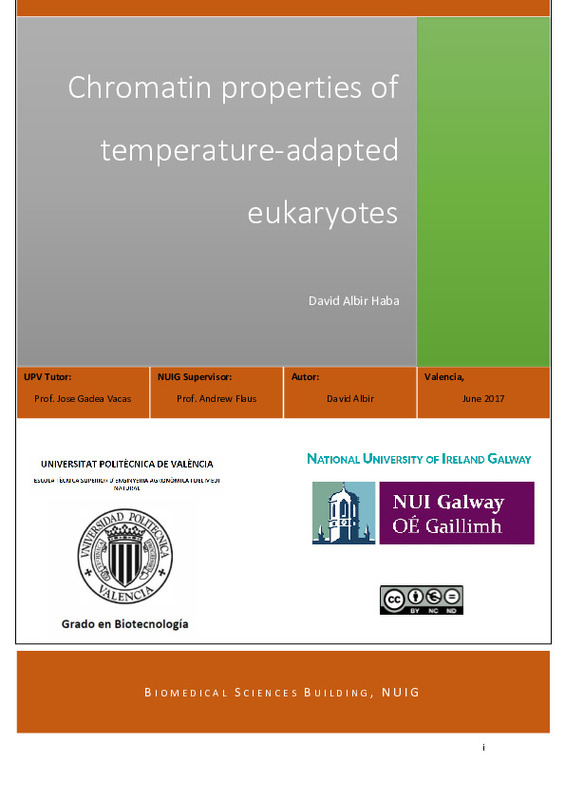JavaScript is disabled for your browser. Some features of this site may not work without it.
Buscar en RiuNet
Listar
Mi cuenta
Estadísticas
Ayuda RiuNet
Admin. UPV
Chromatin properties of temperature-adapted eukaryotes
Mostrar el registro sencillo del ítem
Ficheros en el ítem
| dc.contributor.advisor | Gadea Vacas, José
|
es_ES |
| dc.contributor.advisor | Flaus, Andrew
|
es_ES |
| dc.contributor.author | Albir Haba, David Carlos
|
es_ES |
| dc.date.accessioned | 2017-09-05T11:14:25Z | |
| dc.date.available | 2017-09-05T11:14:25Z | |
| dc.date.created | 2017-06-28 | |
| dc.date.issued | 2017-09-05 | es_ES |
| dc.identifier.uri | http://hdl.handle.net/10251/86422 | |
| dc.description.abstract | [EN] Chromatin packaging is linked with the genome sequence, molecular mechanisms and biological properties of cells. We hypothesize that the histone proteins packaging cold-living eukaryotes (psychrophiles) have enhanced flexibility over mesophiles such as commonly studied animals and fungi, whereas the histones of warm adapted eukaryotes (thermophiles) have enhanced stability compared to mesophiles. In this project we will use synthetic genes to recombinantly express and purify histones with sequence of the Antarctic fish Notothenia coriiceps living below 4ºC and the fungus Chaetomium thermophilum with optimum living temperature of 60ºC. We attempted to assemble these into histone octamers and nucleosomes to enable comparison of their properties with human equivalents. | es_ES |
| dc.description.abstract | [ES] La compactación de la cromatina está relacionada con la secuencia genómica, los mecanismos moleculares y las propiedades biológicas de las células. Se hipotetiza que el compactamiento de las proteínas histonas de los animales eucariotas adaptados al frio (psicrófilos) han ganado en flexibilidad frente a los mesófilos. En cambio las histonas de los eucariotas adaptados a altas temperaturas (termófilos) como los hongos han ganado en estabilidad en comparación frente a los mesófilos. En este proyecto genes recombinantes serán usados para expresar y purificar las histonas del pez de la Antartida Notothenia coriiceps que vive por debajo de los 4ºC y el hongo Chaetomium thermophilum con una temperatura óptima de desarrollo de 60ºC. Se ensamblaran estas histonas en octámeros y nucleosomas para permitir la comparación de sus propiedades con sus equivalentes humanos. | es_ES |
| dc.format.extent | 44 | es_ES |
| dc.language | Inglés | es_ES |
| dc.publisher | Universitat Politècnica de València | es_ES |
| dc.rights | Reconocimiento - No comercial - Sin obra derivada (by-nc-nd) | es_ES |
| dc.subject | Histones | es_ES |
| dc.subject | Temperature-adapted | es_ES |
| dc.subject | Chromatin | es_ES |
| dc.subject | Eukaryotes | es_ES |
| dc.subject | Fungi | es_ES |
| dc.subject | Bacteria | es_ES |
| dc.subject | Thermophiles | es_ES |
| dc.subject | Mesophiles | es_ES |
| dc.subject | Histonas | es_ES |
| dc.subject | Adaptacion a la temperatura | es_ES |
| dc.subject | Cromatina | es_ES |
| dc.subject | Hongos | es_ES |
| dc.subject | Bacterias | es_ES |
| dc.subject | Termófilo | es_ES |
| dc.subject | Eucariotas | es_ES |
| dc.subject.classification | BIOQUIMICA Y BIOLOGIA MOLECULAR | es_ES |
| dc.subject.other | Grado en Biotecnología-Grau en Biotecnologia | es_ES |
| dc.title | Chromatin properties of temperature-adapted eukaryotes | es_ES |
| dc.type | Proyecto/Trabajo fin de carrera/grado | es_ES |
| dc.rights.accessRights | Abierto | es_ES |
| dc.contributor.affiliation | Universitat Politècnica de València. Escuela Técnica Superior de Ingeniería Agronómica y del Medio Natural - Escola Tècnica Superior d'Enginyeria Agronòmica i del Medi Natural | es_ES |
| dc.contributor.affiliation | Universitat Politècnica de València. Departamento de Biotecnología - Departament de Biotecnologia | es_ES |
| dc.description.bibliographicCitation | Albir Haba, DC. (2017). Chromatin properties of temperature-adapted eukaryotes. http://hdl.handle.net/10251/86422 | es_ES |
| dc.description.accrualMethod | TFGM | es_ES |
| dc.relation.pasarela | TFGM\66066 | es_ES |
Este ítem aparece en la(s) siguiente(s) colección(ones)
-
ETSIAMN - Trabajos académicos [3545]
Escuela Técnica Superior de Ingeniería Agronómica y del Medio Natural






